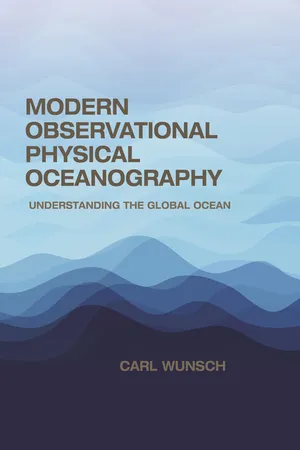
- 512 pages
- English
- PDF
- Available on iOS & Android
About This Book
The essential introduction to modern physical oceanography With the advent of computers, novel instruments, satellite technology, and increasingly powerful modeling tools, we know more about the ocean than ever before. Yet we also have a new generation of oceanographers who have become increasingly distanced from the object of their study. Ever fewer scientists collect the observational data on which they base their research. Instead, many download information without always fully understanding how far removed it is from the original data, with opportunity for great misinterpretation. This textbook introduces modern physical oceanography to beginning graduate students in marine sciences and experienced practitioners in allied fields. Real observations are strongly emphasized, as are their implications for understanding the behavior of the global ocean.Written by a leading physical oceanographer, Modern Observational Physical Oceanography explains what the observational revolution of the past twenty-five years has taught us about the real, changing fluid ocean. Unlike any other book, it provides a broad and accessible treatment of the subject, covering everything from modern methods of observation and data analysis to the fluid dynamics and modeling of ocean processes and variability. Fully illustrated in color throughout, the book describes the fundamental concepts that are needed before delving into more advanced topics, including internal-inertial waves, tides, balanced motions, and large-scale circulation physics.
- Provides an accessible introduction to modern physical oceanography
- Written by a leading physical oceanographer
- Emphasizes real observations of the fluid ocean
- Features hundreds of color illustrations
- An online illustration package is available to professors
Frequently asked questions
Information
Table of contents
- Cover
- Half Title
- Title
- Copyright
- Dedication
- Contents
- Preface
- 1 Introduction
- 2 Observing the Ocean
- An Interlude
- 3 What Does the Ocean Look Like?
- 4 Linear Wave Dynamics
- 5 Observations of Internal and Inertial Waves
- 6 The Tide Disturbing Potential and the Milankovitch Forcing
- 7 Observations of Tides and Related Phenomena
- 8 Balanced Motions
- 9 The Time-Mean Ocean Circulation
- 10 Large-Scale Circulation Physics
- 11 Interpreting and Using the Circulation
- 12 Low-Frequency, Time-Varying, Global-Scale Flow
- A Brief Afterword
- A A Primer of Analysis Methods
- B Inverse and State Estimation Methods
- C Problematic Terms and Concepts
- D Useful Numerical Values
- E Notation, Abbreviations, and Acronyms
- References
- Index
- Blank Page